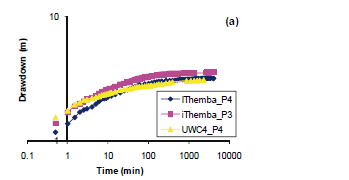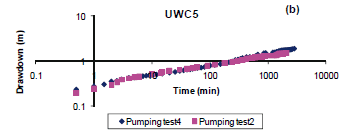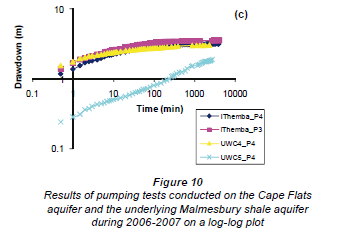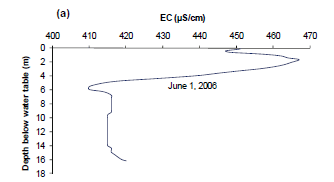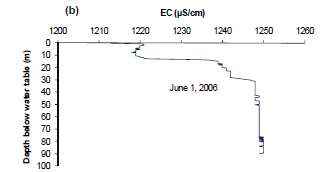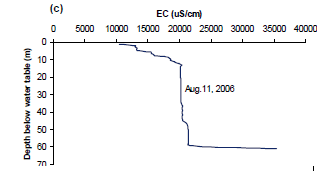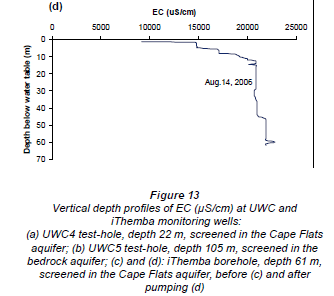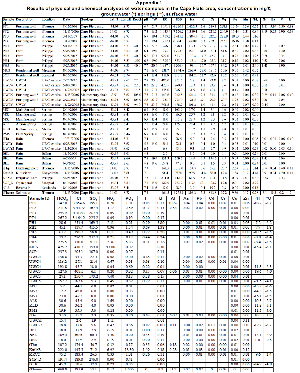Servicios Personalizados
Articulo
Indicadores
Links relacionados
-
 Citado por Google
Citado por Google -
 Similares en Google
Similares en Google
Compartir
Water SA
versión On-line ISSN 1816-7950
versión impresa ISSN 0378-4738
Water SA vol.36 no.4 Pretoria jul. 2010
A conceptual model for the development and management of the Cape Flats aquifer, South Africa
Segun AdelanaI,*; Yongxin XuII; Petr VrbkaIII
IGeology and Mineral Sciences Department, University of Ilorin, PMB 1515, Ilorin, Nigeria
IIEarth Sciences Department, University of the Western Cape, Bellville, South Africa
IIIDieburger Str. 108, D-64846 Groß-Zimmern, Germany
ABSTRACT
This paper provides an integrated approach to the analysis of the geological, hydrological and hydrogeological characteristics of the Cape Flats: a coastal plain sand formed within the mountains of the Cape Town metropolitan area. The study is mainly based on evaluation of available data, on surface water and groundwater, rainfall and selected springs, to describe the Cape Flats aquifer. Qualitative analysis has shown that both surface water and groundwater of the investigated area are of good quality; whereas sources of contamination indicated are restricted to certain parts of the area. Interpretation of hydrogeological data and aquifer parameters revealed that the Cape Flats aquifer has good storage characteristics to support its development for water supply, although the generally unconfined conditions render it highly susceptible to pollution from the surface. From the analysis of long-term climate data in Cape Town, it is evident that fluctuation exists in the pattern of rainfall; this rainfall pattern has implications for recharge and water management issues in the city. Therefore, a conceptual hydrogeological model was developed to elucidate groundwater flow and recharge mechanisms in the Cape Flats.
Keywords: water resource management, Cape Town, water quality, surface-water/groundwater relations, conceptualisation
Introduction
The geographical location of the sand-covered coastal plain (Cape Flats) is shown in Fig. 1. On this map the Cape Flats is taken to be the area bounded by the Cape Town - Muizenberg, Cape Town - Bellville - Kraaifontein and Bellville - Eerste River - Strand railway lines and the False Bay coast, with a narrow strip of sand along the western coast, extending northwards from Cape Town and Bellville through Bloubergstrand up until Atlantis (Fig. 1). This large undulating sandy area connecting the hard-rock of the Cape Peninsula with the mainland is known as the Cape Flats (Schalke, 1973; Theron, 1984; Theron et al., 1992). The Cape Flats sand is more susceptible to pollution as a result of industrialisation, urbanisation and intense use of the land area for waste disposal and agricultural purposes. The overall aim of this research project is to provide information on the Cenozoic sand cover of the Western Cape, particularly with regard to its hydrological and hydrogeological behaviour that may favour aquifer development and management.
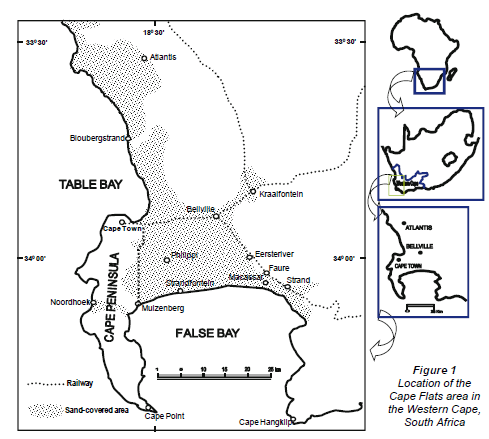
The Cape Flats, covering a surface area of 630 km2, falls under the City of Cape Town Water Management Area (WMA), an extensive area of approximately 2 159 km2. Presently, most of the area underlain by the Cape Flats aquifer is built up, which has given the area both an urban and industrial face-lift. Cape Town's central business district is on the western edge of the Cape Flats with part of the city and its suburbs entirely underlain by Cenozoic sands. Detailed physiographic description of the present study area and the demographic growth of the city have been presented in Adelana and Xu, 2008.
Information on boreholes and well points in the Western Cape is found in the National Groundwater Database. The location, altitude, depth and source of each well are recorded in detail in the database, where stratigraphic and piezometric data, as well as the measured physical and chemical data on groundwater are archived. Some of these have been collated and utilised in this study. The geological and hydrogeological features of the study area have been inferred from the data analysis of these boreholes, with few additional wells sampled during the course of this study. All acquired knowledge and information are to be utilised to propose management guidelines to prevent further degradation of this groundwater resource, which at the moment is under-utilised.
Geomorphology and geology of the Cape Flats
The Cape Flats area is essentially lowland. Generally, the WMA has a varied terrain, ranging from low-lying sandy plains (with an average elevation of 30 m a.m.s.l.) to rocky mountains (the Cape Peninsula mountain chain) with a series of peaks, rising to up to 1 038 m on Table Mountain and dropping sharply to the sea in many parts of the peninsula. Topographical features are varied and include narrow flats, kloofs and gorges, cliffs, rocky shores, wave-cut platforms, small bays, and sandy and gravel beaches (Theron, 1992). On the Cape Flats sand dunes are frequent with a prevalent south-easterly orientation; the highest dunes are approximately 65 m a.m.s.l.
The oldest rocks in the Western Cape are meta-sediments of the pre-Cambrian Malmesbury Group (Ne), which occupy the coastal plain between Saldanha and False Bay, in the west, and the first mountain ranges in the east. Several erosional windows to this group are exposed in mainly fault-controlled valleys further to the east and south, of which the Breede River valley is the most conspicuous (Meyer, 2001). The Malmesbury Group consists of low-grade metamorphic rocks such as phyllitic shale, quartz and schist, siltstone, sandstone and greywacke.
The Cape Flats is a component of the 'Late-Tertiary and Recent sands' unit of the Western Cape, overlying the Malmesbury Shale (Theron et al., 1992), which are in places up to 50 m thick. Figure 2 shows the geological map of the area around the Cape Flats, in the southwestern Cape. Several geologic sections drawn based on previous and present information (Henzen, 1973; Gerber, 1981; Vandoolaeghe, 1989; Adelana and Xu, 2008) are presented in Fig. 3. Although this sand cover is rather thin in relation its wide lateral extent, practically no outcrops occur.
On the Cape Flats are sediments of Quaternary age that blanket the Neogene deposits, of which little is known except from boreholes and quarries (Theron et al., 1992). These are all Cenozoic sediments of the Western Cape referred to as the Sandveld Group (Hendey and Dingle, 1983), which include Quaternary sediments formerly incorporated with the 'Bredasdorp Formation' (Visser and Schoch, 1973; Rogers, 1982) while the Bredasdorp Group is restricted to Cenozoic Formations east of Cape Hangklip (Malan, 1987; Theron et al., 1992). The Cenozoic Formations of the Western Cape and its lithostratigraphic units are presented in Table 1.
According to Henzen (1973) and Vandoolaeghe (1989), portions of the area of the Cape Flats (particularly along the False Bay coast between Muizenberg and Macassar) are covered by calcareous sands and surface limestone deposits while silcrete, marine clays and bottom sediments of small inland vlei deposits also occur sporadically (Hartnady, 1987). The bedrock topography shows that there is a Palaeo-valley reaching more than 40 m b. m. s. l. towards the northeastern portion of the area (Theron et al., 1992). The details and full description of geology of the Cape Flats has been reported in Henzen (1973), Vandoolaeghe (1989) and Theron et al. (1992).
The sands are derived from 2 sources:
• Weathering followed by deposition, under marine conditions, of the quartzite and sandstones of the Malmesbury Formation and Table Mountain Group (TMG)
• The beaches in the areas, from where aeolian sand was deposited as dunes on the top of the marine sands.
The marine sands were deposited in accordance with the prevailing sea level and the sand body is horizontally stratified with several lithostratigraphic units identified (Table 1). The process of sedimentation was initiated in a shallow marine environment, subsequently progressing into intermediate beach and wind-blown deposits, and finally to aeolian and marshy conditions, leading to the formation of peaty lenses within the sands. The inter-relationships of the various formations are known from many boreholes and exposures within and outside the greater Cape Town area (Theron et al., 1992). Figure 4 shows the litho-logs of typical monitoring wells recently drilled at the University of the Western Cape Test Site; the monitored data from these boreholes are included in this study.
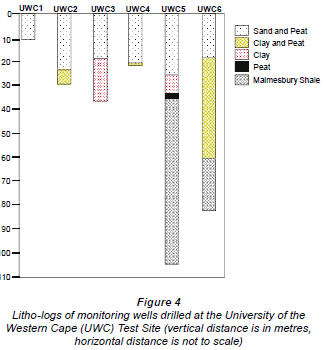
Hydrological conditions
Climate characteristics
The Cape Flats has a typical Mediterranean climate with a hot and relatively dry summer and cold and wet winter. However, the generally mountainous nature of the Cape Fold Belt results in the entire region having sharp changes in climate.
There are several hydrological stations in and around Cape Town but in order to assess rainfall fluctuations time series of yearly long-term rainfall data of Cape Town Airport were analysed. The climate data from Cape Town Airport reveals annual precipitation of the Cape Flats area varies mainly between 400 and 800 mm. There is a dry period with less than 20 mm rainfall per month from November to March; the mean annual temperature is moderate, approximately 17ºC. Figure 5 shows the mean temperature variation together with monthly rainfall in Cape Town for a time record of 73 years (1933-2006). The prevailing southeast trade winds in summer are replaced by northwest anti-trade winds in winter, the latter spelling rainy weather. Very strong winds are frequent and characteristic of the Cape Flats area.
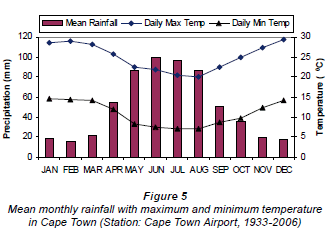
Yearly precipitation data for a time period of 165 years, from 1841-2006, show strong fluctuations between 229 mm and 1 037 mm; the mean annual precipitation over this period is 619 mm (Fig. 6). Summer temperatures are mild, with an aver age maximum of 26ºC. The long-term variation air temperature in Cape Town is presented in Fig. 7(a) and (b). The winter months are cool, with an average minimum temperature of 7ºC. About 80% of the annual precipitation occurs in winter time.
From the analysis of climate data in Cape Town, the highest amount of precipitation was recorded in 1892 with 1 037 mm, the lowest in 1935 with 229 mm. The maximum downpour is in June, while precipitation is in its minimum in February. Moreover, positive and negative trends become evident when the entire time series is examined in segments of 50 years. The first 50 years (1841-1891) in the time series show a significant positive trend, whereas a significant negative trend is noted when the 50-year segment is taken at the end of the record (1956-2006). A change of mean was obvious when the average of annual rainfall for the entire record was calculated by decades. The pattern and variability of the precipitation in Cape Town is as follows: the average of annual rainfall was increasing until 1891; from 1892 the trend showed continuous decrease up until 1941, but there was a 'climatic jump' about 1941-1942. Such a 'climatic jump' occurred much later in the Sahel of Western Africa, about 1969-1970, as reported by Hubert and Carbonnel (1987). This coincided with the period when the probability of a sudden change in the mean reached a maximum.
The fluctuations in Cape Town rainfall are further illustrated by the 'rising' and 'dropping' 10-year means in Fig. 6. The figure shows the 2 decades from 1921-1941 as relatively dry periods; least annual rainfall of 229 mm was recorded in 1935. A similarly low rainfall was observed from 1999-2003, with the exception of the year 2001 (with up to 784 mm). This fluctuation in the rainfall pattern has implications for groundwater recharge and, consequently, water management issues in the area.
Hydrological balance
The surface water hydrology of the Cape Flats area is represented by the Eerste River, Kuils River and the Diep River, as well as Zeekoevlei and other open water bodies (Fig. 8). Other streams and creeks are Lourens, Elsieskraal, Lotus Hout, Sout, Liesbeek, and Sir Lowry's Pass, which are mostly tributaries discharging into the main rivers. In several depressions, flat marshy sites - locally named 'vleis' (Schalke, 1973) - are present, which sometimes contain open water and are connected by a river with the sea. The drainage towards the south takes place by the Eerste River and by the Zeekoevlei into False Bay, whereas in the north the Sout and Diep River drain into Table Bay.
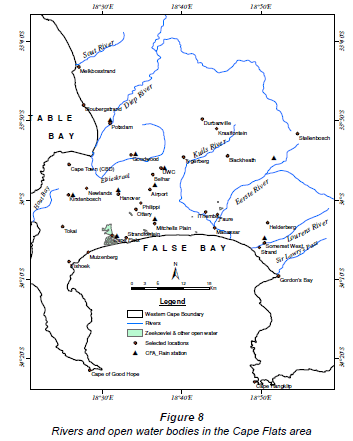
In the study area, runoff measurements are limited. There are gauging stations on Diep and Eerste River while Kuils River is a tributary of Eerste River and no longer has a gauging station (Table 2). Small-scale irrigation ponds and canals are available in the farming areas around Otery and Philippi. These and other minor drains covering a small area were not quantified.
The parameters of the hydrological balance are shown in Table 3 and are results of the analysis of available runoff data as well as estimates using the Thornthwaite and Mather (1957) method.
According to Gerber (1981), the maximum flow rate of the Lotus River at its entry point into Zeekoevlei - using manual measurements (winter of 1980) - was 11 000 m3/h in response to a rainfall intensity of 50 mm/d at the height of the rainy season. The corresponding figure for the upper stretches of the Elsieskraal River, at its crossing with Hein road, was estimated at 2 000 m3/h (Gerber, 1981). The 'baseflow' component of the Great Lotus River was in the range of 400 to 1 000 m3/h.
The parameters of water balance for the year 2002-2003, such as precipitation, surface runoff, estimates of actual evapotranspiration together with recharge, are listed in Table 3 for 3 selected stations, based on the method of Thornwaite and Mather (1957). If the groundwater recharge is low, a large part of the precipitation is lost to evapotranspiration and vice versa. The recharge value is in the proportion of 16 to 47% of precipitation.
In field observations, irrigation may be significant to water balance as the farmers in the area irrigate their crops during the dry summer months, but there are no data to show the extent of water use for irrigation in the study area. Assuming a conservative value of 1 000 mm mean annual rainfall over the study region of 630 km2, the total volume of rainfall is 6.30×108 m3/a. There are 211 irrigation permits within the study area (as at 2006). Assuming a conservative, 60-day long irrigation season, the total amount of returned irrigation water is 1.03×105 m3/a or 0.0163% of the rainfall. If the irrigation season was 365 days long, irrigation water would only amount to 0.1% of the rainfall over the study area.
Hydrogeological conditions
The Sandveld Group (which is essentially Cenozoic sediments) forms an extensive sand aquifer that is hydrogeologically divided into 4 main units (Meyer, 2001):
• The Cape Flats aquifer unit
• The Silwerstroom-Witzand unit in the Atlantis area
• The Grootwater unit in the Yzerfontein region
• The Berg River unit in the Saldanha area.
Analysis of about 500 boreholes in the Sandveld Group indicates that 41% of boreholes yield <0.5  /s while 30% yield >2
/s while 30% yield >2  /s (Meyer, 2001). The potential yield within the different units of the Sandveld Group is shown in Table 4. The presence of intermittently flowing springs reveals the occurrence of aquifers of low potential, which are possibly formed only within fractured zones or locally within the weathered zone. Detailed hydrogeological investigation of the Cape Flats aquifer is presented and discussed in the following section.
/s (Meyer, 2001). The potential yield within the different units of the Sandveld Group is shown in Table 4. The presence of intermittently flowing springs reveals the occurrence of aquifers of low potential, which are possibly formed only within fractured zones or locally within the weathered zone. Detailed hydrogeological investigation of the Cape Flats aquifer is presented and discussed in the following section.
Aquifer parameters
The well distribution in the Cape Flats area which was used in the present study is shown in Fig. 9. The wells exploited and few boreholes used for pumping tests are included and indicated in the figure. A log-log plot of drawdown versus time for 2 pumping test sites is given in Fig. 10.
In the Malmesbury aquifer the drawdown plot for Borehole 5 at University of the Western Cape (UWC 5) shows a fairly straight line suggesting linear flow. The overlying weathered horizon provides storage for the bedrock aquifer. For Borehole 4 (UWC 4) the curve can be fitted to a Theis type curve suggesting a radial flow pattern and indicating homogeneous conditions in the Cape Flats aquifer. It is, generally, hydraulically similar to that of a porous medium and good storage characteristics in the deeply weathered zone.
In spite of similar pumping rates in the 2 wells, results of tests conducted on the Cape Flats aquifer and the underlying Malmesbury shale aquifer have shown that the transmissivity is higher in Borehole 5 than in Borehole 4 (Fig. 10). Figure 10(a) shows pumping test results from boreholes in different locations (from UWC test site, Bellville and iThemba Labs, Faure) all tapping the Cape Flats aquifer; while Fig. 10(b) illustrates the close agreement between 2 pumping tests on UWC5 conducted in 2 different seasons (November and March, respectively). Figure 10(c) compares pumping test data from the 3 boreholes.
In order to determine the aquifer parameters, data sets from 4 pumping tests from the 2 sites, UWC and iThemba, were interpreted by manual and by Excel-fitted curve methods. Figure 11 shows a sample of the plots for pumping and recovery tests conducted during the study while the results of aquifer test interpretations are presented in Table 5.
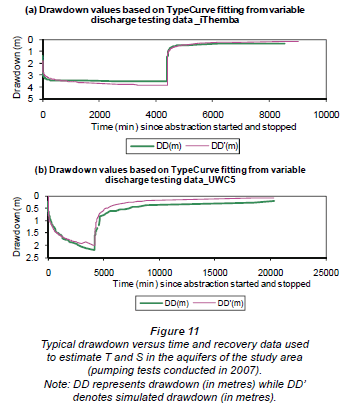
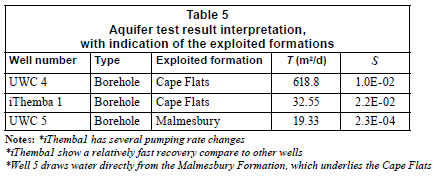
The hydraulic conductivity of the Cape Flats aquifer has been evaluated in earlier studies (Gerber, 1976; Vandoolaeghe, 1989). For example, from the work of Gerber (1976; 1981) a transmissivity distribution map (Fig. 12) has been produced and refined to delineate the best areas of the Cape Flats for implementing groundwater development schemes. According to Gerber (1981) the transmissivity values for the Cape Flats aquifer range from <50 m2/d to 600 m2/d and corroborate the estimates obtained in the present study (see Table 5).
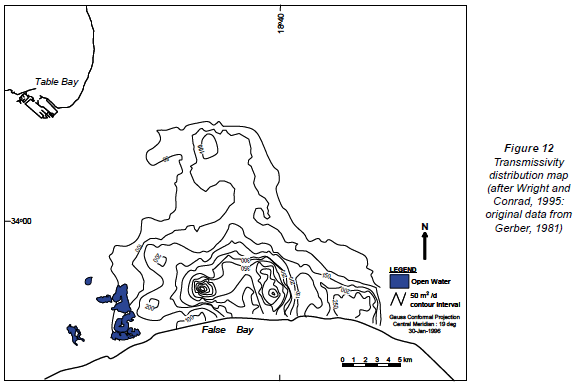
Surface water and groundwater quality
Table 6 gives a summary of the groundwater monitoring networks on the Cape Flats and the various institutions or departments responsible for the database. Aquifer exploitation takes place by means of water supply and irrigation wells to meet the needs of the specific area. In the city of Cape Town several private shallow wells or well-points exist and are in regular use (since the 2005 water restrictions) for wetting lawns and gardens in schools, public places and individual households. The water sources available are groundwater, river water and water from canals or irrigation ponds. There is a large data set for the city of Cape Town and suburbs - over 1 000 chemical analyses with records from 1967-2005.
The data collected are mainly general water chemistry, viz., anions, cations and trace metals in monitoring wells. The sampling carried out between 2005 and 2007 was aimed at describing the current trend in water quality and at filling gaps in the data by sampling from recently drilled wells. The results are presented in Appendix 1. Furthermore, precipitation samples were collected as there were no precipitation records in the database. Rain samplers were installed at UWC and iThemba Laboratory test sites, as well as around residential areas in Belhar (near Bellville) and Macassar.
Generally, groundwater samples have a TDS range of 260 to 1 600 mg/ , with the exception of iThemba wells, where high Na-Cl concentrations were recorded, which may be in response to continuous long-term pumping or the presence of a historic buried river channel near the well and the proximity of the sea. The TDS within surface waters sampled within the study area was, in most cases, lower than for groundwater, with the exception of the 2 polluted ponds at iThemba, where dissolved solids ranged between 952 and 1 113 mg/
, with the exception of iThemba wells, where high Na-Cl concentrations were recorded, which may be in response to continuous long-term pumping or the presence of a historic buried river channel near the well and the proximity of the sea. The TDS within surface waters sampled within the study area was, in most cases, lower than for groundwater, with the exception of the 2 polluted ponds at iThemba, where dissolved solids ranged between 952 and 1 113 mg/ during the 4 sampling episodes. Water from the pumping well at iThemba is discharged into these ponds, coupled with the treated wastewater from the laboratories. Newlands reservoir water recorded a low TDS (98 mg/
during the 4 sampling episodes. Water from the pumping well at iThemba is discharged into these ponds, coupled with the treated wastewater from the laboratories. Newlands reservoir water recorded a low TDS (98 mg/ ), in the range of the springs. This is raw water transported from the Berg River (several kilometres away) to be used for the city's water supply.
), in the range of the springs. This is raw water transported from the Berg River (several kilometres away) to be used for the city's water supply.
Figure 13 shows results of vertical EC loggings at three selected monitoring wells in the study area. A relatively higher EC with depth was observed for iThemba Labs test borehole before and after a 72-h pumping test (Fig. 13 c, d). A water quality (salinity) map (Fig. 14) was based on EC distribution across all boreholes in the study area. All the sampled wells showed nitrate levels within acceptable limits except for wells in Macassar, which are mostly in excess of the drinking water standard of 10 mg/ (as NO3-N) or 50 mg/
(as NO3-N) or 50 mg/ (as NO3). These are mostly wells used for irrigating vegetable (backyard) gardens within the residential area. This shows that the trend observed in the 1980s and 1990s of increasing nitrate concentration, reported in Adelana and Xu (2006), may have changed in recent times.
(as NO3). These are mostly wells used for irrigating vegetable (backyard) gardens within the residential area. This shows that the trend observed in the 1980s and 1990s of increasing nitrate concentration, reported in Adelana and Xu (2006), may have changed in recent times.
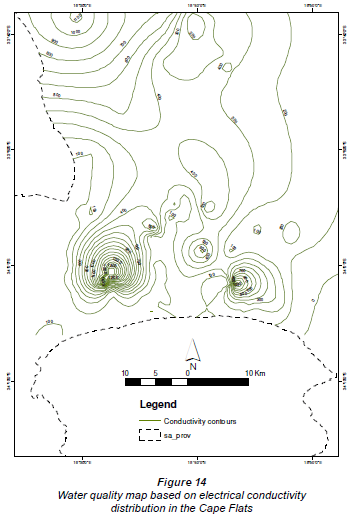
The physico-chemical characteristics described above (with parameters in Appendix 1) and the piper diagram in Fig. 15 allow for the following conclusions on water chemistry to be drawn:
• Groundwater samples from iThemba pumping well have a distinctive chemical type characterised by Na-Cl, which indicates that the chemical properties of the groundwater are influenced by high salinity
• The chemical type for the other groundwater samples is varied (Ca-HCO3, Na-Ca-Cl-SO4, Na-Ca-Cl-HCO3) with the springs also falling within this range
• Most of the surface water samples are characterised by Ca-HCO3 and Ca-Na-HCO3, which appears to be of calcitic type with anion dominance also tending towards the axis of sulphides and chlorides on the tri-linear Piper diagram.
The samples from springs (from 6 locations) have TDS range of 67-125 mg/ , with a mean of 81.4 mg/
, with a mean of 81.4 mg/ ; rainwater samples ranged from 3.2 to 67 mg/
; rainwater samples ranged from 3.2 to 67 mg/ with a mean of 32.1 mg/
with a mean of 32.1 mg/ . Elemental ratios and isotopic compositions (i.e., anions, cations, and stable isotopes) are also similar to that of groundwater (see Appendix 1). The springs show low ion concentrations and a low depletion in isotopic composition, indicating that the groundwater circulation may be relatively quicker in the mountain area. This is discussed in the following section.
. Elemental ratios and isotopic compositions (i.e., anions, cations, and stable isotopes) are also similar to that of groundwater (see Appendix 1). The springs show low ion concentrations and a low depletion in isotopic composition, indicating that the groundwater circulation may be relatively quicker in the mountain area. This is discussed in the following section.
Hydrogeological model and concept of recharge
A hydrogeological model was developed to elucidate groundwater flow mechanisms and possibilities of recharge in the Cape Flats. The model is based on local climate, hydrology, geomorphology, geology and chemical and isotope geochemistry (Fig. 16). The groundwater from the Cape Flats aquifer is of meteoric origin with an isotopic regression line similar to the regional meteoric water line (Harris et al., 1999). Recharge occurs in the mountainous flanks of the western and southwestern (Cape Peninsula and Table Mountains), eastern/southeastern. In these areas, the recharge is a high percentage of the local precipitation, which exceeds 800 mm in places, e.g. Kirstenbosch (Fig. 8). Surface runoff and overland flow are sometimes high, causing tributaries to discharge (higher flows) into the main rivers (e.g. Eerste River).
In the mountainous part of the city, groundwater recharge is conceptualised as mountain front recharge, and the recharge area is located at a very short distance from the springs. All the spring samples and surface water have isotopic composition similar to that of rain water. The only exception is the Newlands reservoir (see Fig. 8) water, which is relatively more depleted in stable isotopes (δ18O: -4.78 ‰ and δ2H: -24.67‰ as compared to the mean value for precipitation). The reason for this is that the stable isotopes in the water may have been depleted where it originates, at higher elevations, or possibly due to the long transport distance in a pipeline, subjecting the water to a lower evaporation effect relative to surface water. Other surface waters have stable isotope values for δ18O in the range of -2.3 to -1.22 ‰; for δ2H between -9.64 and -4.1 ‰.
The model takes into account results of the following investigations:
• Lithology as revealed through boreholes
• Geomorphology or elevation
• Groundwater fluctuations/variations with respect to height
• Variations of δ 18O and chloride concentrations in groundwater
This model is similar to the description of groundwater flow based on 2 aquifer test sites presented in Gerber (1981). Further, a significant recharge occurs through fractures under saturated or nearly saturated conditions in the TMG (Wu, 2005). There are fracture zones in the neighbouring TMG aquifer resulting in good yield (5-7  /s). The infiltrated water moves laterally through the Cape Flats aquifer until intercepted by relatively deeper wells in the weathered shale (Malmesbury).
/s). The infiltrated water moves laterally through the Cape Flats aquifer until intercepted by relatively deeper wells in the weathered shale (Malmesbury).
From an agricultural perspective, where irrigation water in farm dams and irrigation canals is used for market vegetable and potato cultivation, irrigation water infiltration can contribute to groundwater recharge. These areas are currently experiencing increased urban development. This includes the informal and low-cost formal housing of the Cape Flats, and the middle income development of the West Coast (Table View) as well as new developments such as Century City. However, the low elevation above mean sea level and the proximity to the sea sometimes implies a high local water table. Landfill sites, typically sited in such areas in the past, are prone to seepage and to groundwater contamination.
Implications for the management and development of groundwater under conditions of declining rainfall and high urban growth
The effect of climate variability (described and illustrated with rainfall variability in the previous sections) in the city of Cape Town and its suburbs is expected to increase pressure on water resources from the growing population. Cape Town is the second most populous city in South Africa, and has undergone urban expansion in the past decades. The city has doubled its size since 1977 and is 7 times larger than what it was in 1945 (CCT, 2009). The continued growth of the city is of concern and has necessitated purpose-driven projects including the estimation of future urban growth rates and the development of urban growth models (CCT, 2006). Sustainable water resource management must go along with spatial planning for the future urban population.
The analysis of long-term climate data revealed impacts of variations in air temperature and rainfall and urbanisation on groundwater. Results showed drier and warmer conditions since the last 10 to 15 years (see Figs. 6 to 8). Dam levels in Cape Town were at their lowest levels in 5 years during 2005. Monitoring data from Cape Town has shown fluctuations in water level, particularly the water supply dam, due to fluctuating rainfall patterns and climatic conditions in the last decade. Climate variability is expected to alter the present hydrological resources in Southern Africa and may increase pressure on the adaptability of future water resources.
During the past 20 years, most of Southern Africa experienced droughts, the last 4 being in 1986-1988, 1991-1992, 2000-2001 and 2004-2005 (Mukheibir and Ziervogel, 2006). This drought-induced shortage of water placed stress on water supply in the city of Cape Town. The city has over the past few years had a history of water shortages, before the new water augmentation schemes were proposed (Bishop and Killick, 2002). The most recent water shortage faced by the city was from 2002-2005 that necessitated imposition of water restrictions. The restrictions resulted in increased water and sanitation tariffs to ensure cost recovery and discourage high consumption patterns. This led to investigations on the use of groundwater, not only to augment supply but to lower the cost for water delivery in the city.
Therefore, the option to develop groundwater as an augmentation scheme is not negotiable, as population-driven water demand continues to increase. Groundwater seems to be the most readily available and cheaper option to augment water supply to the city. The Cape Flats aquifer, among other aquifers in the Cape Town area, is the most significant in this regard. Nevertheless, the implications of urbanisation and climate variability in Cape Town, in relation to recharge, are issues to consider. The impact of population growth and expansion of Cape Town has been discussed in a recent comparative evaluation of urban groundwater and recharge in rapidly urbanising cities in Sub-Saharan Africa (Adelana et al., 2008). Estimates of water main leakage in Cape Town are high and, together with, irrigation water may contribute significantly to groundwater recharge. The main man-made impacts on groundwater quality and quantity in the city result from urbanisation and from changes in land use.
Therefore, groundwater resource development and management in the city of Cape Town will require a systematic approach, in view of the hydrogeological characteristics analysed and discussed in this paper. The crucial issue of developing the Cape Flats aquifer for water supply requires technical direction from hydrogeologists and the management of groundwater demands a reasonable level of hydrogeological awareness amongst water stakeholders. Part of the challenge will be to develop locally-appropriate groundwater protection plans for the city as it grows in size and population. Other challenges and future actions will include:
• The development of numerical models on groundwater movement and solute transport
• Taking into account aquifer protection and climate variability while exploiting groundwater in the region
• Properly addressing the relationship between land use planning/management and aquifer protection
• Carrying out detailed groundwater vulnerability mapping.
Summary and conclusions
Previous studies on the use of groundwater and the development of the Cape Flats aquifer have become important under conditions of a changing climate and increasing population within the city of Cape Town. This paper has presented a conceptual hydrogeological model with descriptions of aquifer properties and characteristics. The results have confirmed the need for an integrated management tool to effectively manage both surface water and groundwater in the greater Cape Town area.
The conceptual model shows an unconfined sandy aquifer (Cape Flats sand), grading into semi-confined conditions in some places where lenses of clay and peat exist. The sandy aquifer is underlain by an impervious shaly bedrock aquifer (Malmesbury Shale). These results can be used in a computer simulation model in order to predict the impacts of different groundwater exploitation scenarios. Future detailed information will help to evaluate the effects of groundwater management on the local environment (e.g. the prevention of seawater intrusion). There is a need for groundwater vulnerability mapping and delineation of protection zones to prevent the sensitive (unconfined) aquifer from deterioration.
In summary, the study produced a good understanding of the hydraulic behaviour, recharge mechanism and hydrochemical characteristics of the Cape Flats aquifer, relevant to the present conditions. It has enhanced the knowledge of its physical properties and confirmed the importance of conjunctive use of surface water and groundwater in order to address the problem of water supply reliability in Cape Town.
References
ADELANA SMA and XU Y (2008) Impacts of land-use changes on a shallow coastal aquifer, South-Western Cape, South Africa. Proc. XXXVI Congress of the International Association of Hydrogeologists (IAH), 28 October - 2 November 2008, Toyama, Japan. [ Links ]
ADELANA SMA, TAMIRU A, NKHUWA DCW, TINDIMUGAYA C and OGA MS (2008) Urban groundwater management and protection in sub-Saharan Africa. In: Adelana SMA and MacDonald AM (eds.) Applied Groundwater Studies in Africa. Taylor & Francis, London. 231-260. [ Links ]
ADELANA SMA and XU Y (2006) Contamination and protection of the Cape Flats Aquifer, South Africa. In: Xu Y and Usher B (eds.) Groundwater Pollution in Africa. Taylor & Francis, London. 265-277. [ Links ]
ADELANA SMA, XU Y and ADAMS S (2006) Identifying sources and mechanism of groundwater recharge in the Cape Flats, South Africa: Implications for sustainable resource management. Proc. XXXIV Congress of the International Association of Hydrogeologists (IAH), 9-13 October 2006, Beijing, China. [ Links ]
CCT (CITY OF CAPE TOWN) (2009) City of Cape Town Urban Growth Monitoring Project, Report to Planning and Environment Portfolio Committee, March 2009, City of Cape Town. [ Links ]
CCT (CITY OF CAPE TOWN) (2006) Information and Knowledge Management Department, Population Projections for Cape Town 2001-2021, Phillip Romanovsky report. 13 pp. [ Links ]
GERBER A (1981) A digital model of groundwater flow in the Cape Flats. CSIR Contract Report C WAT 46. CSIR, Pretoria. [ Links ]
HARRIS C, OOM BM and DIAMOND RE (1999) A preliminary investigation of the oxygen and hydrogen isotope hydrology of the greater Cape Town area and an assessment of the potential for using stable isotopes as tracers. Water SA 25 (1) 15-24. [ Links ]
HARTNADY CJH (1987) Tectonostratigraphic terrane analysis and Southern African crustal evolution. Proc. and Abstracts of the Alex I. du Toit Golden Jubilee Conference on Tectonographic Terrane Analysis. Precambrian Research Unit, Cape Town. 4-14. [ Links ]
HENDEY QB and DINGLE RV (1983) Onshore sedimentary phosphate deposits in South Western Africa. Technical Report, Joint Geological Survey/University of Cape Town Marine Geoscience Unit 14 27-40. [ Links ]
HENZEN M (1973) The reclamation, storage and abstraction of purified sewage effluents in the Cape Peninsula (in Afrikaans). D.Sc. Thesis, University of the Orange Free State, Bloemfontein. [ Links ]
HUBERT P and CARBONNEL JP (1987) Statistical approach to aridification of West Africa. J. Hydrol. 95 165-183 [ Links ]
MUKHEIBIR P and ZIERVOGEL G (2006) Framework for adaptation to climate change in the City of Cape Town (FAC4T). Report submitted to the City of Cape Town, Environmental Resource Management. 46 pp. [ Links ]
MALAN JA (1987) The Bredasdorp Group in the area between Gansbaai and Mossel Bay. S. Afr. J. Sci. 83 506-507. [ Links ]
MEYER PS (2001) An explanation of the 1:500 000 hydrogeological map of Cape Town 3317. Department of Water Affairs and Forestry, South Africa. 59 pp. [ Links ]
ROGERS J (1982) Lithostratigraphy of Cenozoic sediments between Cape Town and Elans Bay. Palaeoecology Africa, 15 121-137. [ Links ]
SCHALKE HJW (1973) The upper Quaternary of the Cape Flats area, Cape Province, South Africa. Scripta Geol. 15 1-37. [ Links ]
THERON JN (1984) The geology of Cape Town and environs: Explanation of Sheets 3318CD, 3318DC, 3418AB, 3418Ad, 3418BA. Geological Survey of South Africa. [ Links ]
THERON, JN, GRESSE PG, SIEGFRIED HP and ROGERS J (1992) The geology of the Cape Town area. Explanation on Sheet 3318, Geological Survey, South Africa. 140 pp. [ Links ]
THORNTHWAITE CW and MATHER JR (1957) Instructions and tables for computing potential evapotranspiration and the water balance. Publ. Climatol. 10 (3) 183-311. [ Links ]
VANDOOLAEGHE MAC (1989) The Cape Flats groundwater development pilot abstraction scheme. Technical Report No. GH3655, Directorate Geohydrology, Department of Water Affairs and Forestry, Cape Town, South Africa. [ Links ]
VISSER HN and SCHOCH AE (1973) The geology and mineral resources of the Saldanha Bay area. Mem. Geol. Surv. S. Afr. 63 1-150. [ Links ]
WRIGHT W and CONRAD J (1995) The Cape Flats Aquifer: Current status. CSIR Report No. 11/95. CSIR, Stellenbosch, South Africa. [ Links ]
Received 13 July 2009; accepted in revised form 31 May 2010.
* To whom all correspondence should be addressed. +234 (80) 35779520; fax: +234 (31) 227790; e-mail: sadelana@gmail.com













